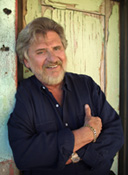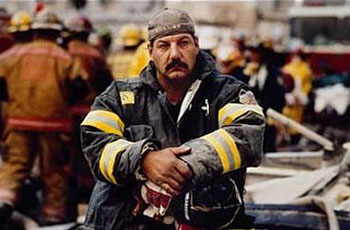 |
→ February 2005 Contents → Commentary
|
Missed Communications
February 2005
|
 |
||||||
|
As a 50-year veteran of news photography, one of the things I know something about is communications via scanners. A majority of working news photographers probably carries one of these receivers that are capable of monitoring police and fire communications on a daily basis. We also listen to each other, especially in big cities, where there are major networks. CNN, for example, in many cities hosts a "city-wide" service for news media that monitors communications on major events.
Until 2001, the New York Fire Department depended on VHF radios that had been in use since 1960. In the spring of 2001 both the NYFD and the Police Department received new digital radios, which had an important feature: the ability to communicate at the leadership level between the two departments. However, in the first months, there were signal strength problems with the new radios, and most importantly, there was a turf war between the fire and police brass over who was going to control the radio use. As a result, most battalion chiefs threw the new radios into the trunks of their cars, while the boxes containing the radios were left unopened on the shelves of the police stations. A VHF radio has limited "line of sight" strength. In a high rise, the limit of the signal is about five floors from the base of the building. In the case of the towers, a signal amplifier or "repeater" had been installed, which would allow the units to communicate throughout the entire complex. However, in the bedlam of the first minutes of response, when Battalion Chief Joseph Pfeizer tried to use the console at the fire desk in the lobby of the North Tower, he found it was dead. He therefore directed all fire fighters to communicate directly with each other on the "talk around" frequency with its limited range. Actually, if the chief had tried to use the repeater frequency on his own hand radio, he would have realized that the repeater was working fine. It was just that he had not pressed the button on the console that would activate it.
Of course, by then millions of people around the world were watching the tragedy unfold live on their TVs. However, the people who most needed to see those pictures, the chiefs in the lobby of the North Tower, had no idea what was going on. However, the police did. Hovering over the North Tower following the collapse of the South Tower, Detective Timothy Hayes, in his helicopter, Aviation 14, radioed to his dispatcher, "Be advised - just not 100 percent sure - but it does appear that the top of the tower might possibly be leaning at this time." A moment later he continued, "It is confirmed, it is buckling and it is leaning to the south." "Which tower is that?" asked the police dispatcher, "one or two?" "The remaining tower, the North Tower, is leaning to the southwest at this time," Hayes said, "and it appears to be buckling at this time in the southwest corner." According to Dwyer and Flynn in "102 Minutes," this was the fourth time that police helicopters had broadcast warnings of the ominous conditions atop the towers. Yet that information was confined to the police radio band. For the firefighters in the North Tower, the first indication they had that they were in imminent peril came when police rescue workers suddenly fled past them down the stairwells. Yet, the firefighters had to put their faith in their own chiefs and their judgment, which as it turned out was not founded on any solid information. There were many plans that had been made by the city that went bad that morning. According to a report issued by Vincent Dunn, a retired Fire Dept. chief, police and fire departments had organized a "Unified Incident Response," which would have had police and fire commanders in direct contact through the new digital radio system. As we have seen that never happened. Yet, if there had been one firefighter assigned as a communications specialist in the team of chiefs managing the event, with even the cheapest Radio Shack scanner (preferably with earphones in order to be able to hear over the sounds of chaos and falling bodies hitting the roof over their heads), that person would have immediately been fully aware of what was going on in the floors above. Even further, if this person had a tiny Radio Shack battery-operated TV monitor, the chiefs would have been able to see what they were up against.
According to Chief Dunn's report, the fire chief on command in the North Tower, Joseph Callan, ordered all firefighters to leave the building at 9:28 a.m. His message was not heard by firefighters on the upper floors. His order to withdraw from the building was given 32 minutes before the first tower, the South Tower collapsed. The North Tower collapsed at 10:28 a.m., one hour after Chief Callan called for all firefighters to leave. Unfortunately, the radios in the North Tower did not transmit his message.
A. The number of falling bodies crashing to the ground was increasing dramatically. B. No elevators were working in that tower. C. Communications were getting weaker and weaker. They went from being bad to worse. Some firefighters heard his message; most did not. D. People coming down the stairs to the lobby were few and far between. It went from a double file of office workers coming out the stairwell into the lobby, to individuals 20 feet apart. He also knew he now had more firefighters than office workers in the upper floors of the North Tower. E. And most importantly, when responding to the fire before entering the lobby, he had a good look at the plane crash damage and the extent of the fire to upper floors. He knew the building could collapse. F. Also, he knew it takes time for firefighters to walk down 40 or 50 stories. The portable radios in the North Tower did not work. Reading Dwyer and Flynn's book, along with some of the other 9/11 reports, such as the one by Chief Dunn, it is impossible not to get sick at the waste of such brave lives, lost doing their best under impossible circumstances to save people who were already beyond salvation. And so much of this could have been avoided if, quite simply, those in command had something as simple as a $150 scanner.
© Dirck Halstead
Editor and Publisher of The Digital Journalist
|
|||||||
Back to February 2005 Contents
|
|

 As a result, once firefighters had climbed past the first floors, they lost all communication with the chiefs. Further, these chiefs had no way of knowing what was going on around them. They did not know that a second plane had hit the South Tower, and more importantly, did not know of the collapse of that tower. By the time the South Tower had collapsed at 9:59 a.m., over 100 firefighters were sprawled on the 35th floor of the North Tower, trying to recover from climbing the stairs lugging all of their heavy equipment.
As a result, once firefighters had climbed past the first floors, they lost all communication with the chiefs. Further, these chiefs had no way of knowing what was going on around them. They did not know that a second plane had hit the South Tower, and more importantly, did not know of the collapse of that tower. By the time the South Tower had collapsed at 9:59 a.m., over 100 firefighters were sprawled on the 35th floor of the North Tower, trying to recover from climbing the stairs lugging all of their heavy equipment. 
 Chief Dunn spoke to Chief Callan and asked him exactly what he had said over the inoperable radio. He said that at 9:28 a.m., he gave the order: "Everyone come down out of the building. Leave the building immediately." Dunn asked him what had made him decide to order firefighters out of the building so early. He stated the following reasons:
Chief Dunn spoke to Chief Callan and asked him exactly what he had said over the inoperable radio. He said that at 9:28 a.m., he gave the order: "Everyone come down out of the building. Leave the building immediately." Dunn asked him what had made him decide to order firefighters out of the building so early. He stated the following reasons: